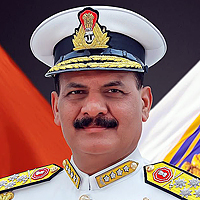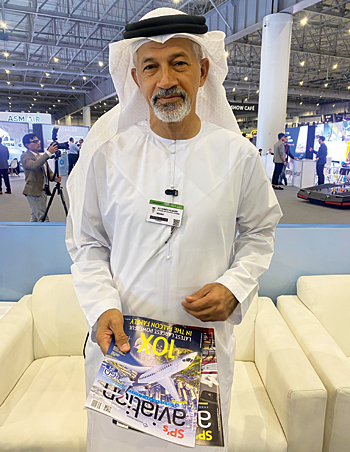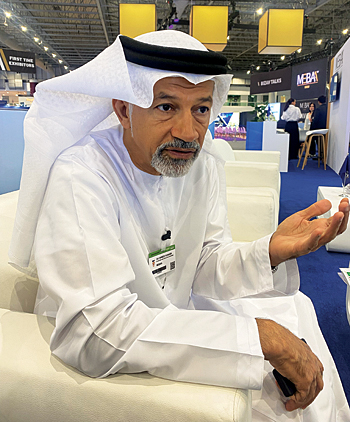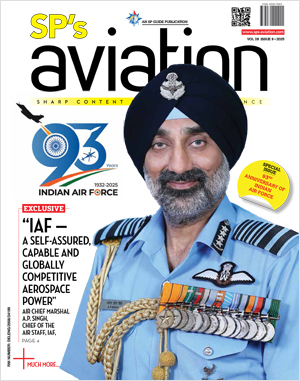INDIAN ARMED FORCES CHIEFS ON OUR RELENTLESS AND FOCUSED PUBLISHING EFFORTS

The insightful articles, inspiring narrations and analytical perspectives presented by the Editorial Team, establish an alluring connect with the reader. My compliments and best wishes to SP Guide Publications.

"Over the past 60 years, the growth of SP Guide Publications has mirrored the rising stature of Indian Navy. Its well-researched and informative magazines on Defence and Aerospace sector have served to shape an educated opinion of our military personnel, policy makers and the public alike. I wish SP's Publication team continued success, fair winds and following seas in all future endeavour!"

Since, its inception in 1964, SP Guide Publications has consistently demonstrated commitment to high-quality journalism in the aerospace and defence sectors, earning a well-deserved reputation as Asia's largest media house in this domain. I wish SP Guide Publications continued success in its pursuit of excellence.
EXCLUSIVE
“The perception is what we have to change”
In an exclusive chat with Jayant Baranwal, Chairman and Managing Director, SP Guide Publications at the recently concluded MEBAA 2024, Ali Ahmed Alnaqbi, Chairman of the IBAC Governing Board, and Founding Chairman, Middle East and North Africa Business Aviation Association (MEBAA) shared his insights and vision on Business Aviation’s Role, Challenges and a Sustainable Future

FOUNDING CHAIRMAN, MEBAA - A FIRM AND DYNAMIC CRUSADER COMMITTED TO THE CONSISTENT GROWTH OF BUSINESS AVIATION INDUSTRY ACROSS THE MIDDLE EAST. HAS BEEN SELECTED AS CHAIR OF IBAC BOARD FOR SECOND CONSECUTIVE TENURE.
Jayant Baranwal (Baranwal): What are the key roles business aviation play in the interest of world countries and society?
Ali Ahmed Alnaqbi (Alnaqbi): Well, business aviation, you know, plays so many roles and the most important is, contribute in the growth of economies. The people who actually make the investment are our clients, so we carry them safely from one place to another place. Our role as business aviation is very important, taking the investors safely from one place to another place. Sometimes, we also take them to a new area where airline cannot reach and that’s the leverage of having a business aircraft. The business aircraft can land not only in a big airport, it can land anywhere, with special permission. Airlines cannot go except to a hub, which we have seen. And then we are, as you know, part of economy development. We are part of the process of creation of jobs. We create jobs for thousands and millions of people around the world.
Business aviation is vital, when it comes to support, you know, like charities, and supporting those companies who needed help. We transfer sick people, who cannot be mingled with others on an airline, from one area to another area. We, in certain area, transfer organs of human to another hospital. It doesn’t go by the airline for various reasons. So, we play so many roles, in addition to our existing set of roles. And one of the main things is, we help in making company profitable. So basically, we work with the companies. And most of the bigger companies in the world, are actually using private and business aircraft. The reason - they save time, and they don’t have to wait so long with the airlines. They also are able to avoid long ques in the airport. And, you know, they want to do business and come back. So, it is a factor of business tool for profitability and creativity and making the company a success.
Baranwal: Can you list down some of the major challenges the industry is still facing?
Alnaqbi: Again, a lot of issues that the business aviation facing mainly come from the understanding and the perception of business aviation. Now, people know what is the airline, but they think we are an airline, too. And when they realise that we are not like an airline, you know, we become an enemy again for them. But actually, the way we work, we contribute and we complement each other. Airline does a certain job, the cargo does certain work and we do certain work for certain people as well. So, the challenge is to change the perception. We are also under, I would say, attack, by protesters in Europe, different regions, because they think that we contribute in the CO2, the carbon emission. And that is absolutely fake, not true. Because if you look at all aviation, they contribute two per cent on CO2. Business aviation is 0.002 per cent of that percentage. So, we are less than two per cent of that two per cent. We are basically contributing nothing in the CO2 emission, but we are still under attack, because we don’t talk loudly and we don’t speak too much. That’s why we change the perception by doing shows. And we ask everybody to come and see this is what we are actually doing. Other things like the grey market and everywhere, it’s always a problem. And we really work very hard to eliminate that. Have we succeeded? No. But we are working on it. So many people have to work together in order to get results.
“When we started MEBAA in 2006, there were a few companies in the whole region doing business aviation. Now in the region we have more than 370 companies.”
Baranwal: How do you find the journey of MEBAA and the industry in the Middle East?
Alnaqbi: Well, we started MEBAA in 2006. There were a few companies in the whole region doing business aviation. There was one company in Jordan, three companies in UAE, four companies in Saudi, and so on and so forth. It was a very shy business. MEBAA came and started promoting the business, started talking to everybody. It is not luxury services only, but it’s a business tool. So, business aviation is there for profitability for the reasonably bigger companies which need to save time, to fly to places where an airline cannot go. So, we started talking about all this, and then things have changed. A lot of companies started joining this region. Now in the region we have more than 370 companies doing charter, doing MROs, doing FBOs, doing refueling. All this has been done by the companies who serve airlines, but now have a dedicated company for us. So, in UAE, for example, if you look at the 2000s, there were about three companies. Now we have more than 35 companies. More than 10 times in Dubai, in Saudi and in Egypt. So, the market is growing, and MEBAA has paved the road for companies from abroad to come and check the opportunity here. And when they come and see the opportunity, within a few years you see they are opening their branches. Or, they move their headquarters to UAE, or the Middle East in general, for example. So that’s a big growth driver.

Baranwal: You will agree that the US still remains the biggest business aviation market. Why is it then visible that NBAA (their in-country body for business aviation industry) continues to fight for their rights?
Alnaqbi: Well, as I mentioned, the perception is what we have to change. The perception of business aviation is a lot of VIPs own aircraft, a lot of decision-makers own aircraft. A lot of people who are very rich, high net worth, own aircraft. The people don’t see beyond. As that represents maybe 30 per cent of our business. The other 70 per cent is corporate, which is for business. You have other 70 per cent of the market size doing chartering and doing corporate. So, in a market like the US, which has been there for quite a long time, it’s saturated. And now it’s come to the point that we have to fight with somebody. So, this is existing. When you become a success, like the NBAA, like the US market which is huge and very successful, there is a price you have to pay. And that’s what we are seeing now. You see my point? Again, it’s one country, it’s controllable. The problem is here, in our region, when you have 24 countries. And you have to have an agreement from all the countries when you want to implement rules that help the business aviation or regulations. So, this is where the challenge is. But I think we were all going, at one stage, to convince everybody of our existence. Because our success, business aviation success, we become a threat to others. So, you then expect to be attacked. That’s what happened in the United States. But again, more visibility for us, more help from the media, more help of showing our case and showing our stories and telling the world what we are actually doing. I think, all this will change the perception.
Baranwal: And how do you see the upcoming role of business aviation industry towards a greener future?
Alnaqbi: Of course, this is very important. Sustainability for us is essential. And SAF has been endorsed to be used fully by 2050. And of course, from IBAC perspective, which has an office at ICAO, we are fully committed to this. So, if you look at all aircraft now, all the new aircraft, their efficiency. They always come with a new product, new technology, efficiency therefore less carbon, less fuel. They’re all green. They’re all using SAF fuel. It’s all contributing to this. So yes, we are understanding it. And we are working towards making, contributing to have the world reduce CO2.
Baranwal: The cost of SAF is an issue?
Alnaqbi: It’s always an issue. What comes first, chicken or egg? Because when you produce something new, it’s very expensive. And you only can reduce the cost if there’s so much demand or good demand. If you manufacture 10 aircraft versus manufacturing 1,000 aircraft, the cost would be different. And that’s what actually happens. So now the debate is about availability. What we are telling the companies is that you need to ask for it so that we can provide it to you. I think eventually this will be our direction, where we’re going.
Baranwal: And is the goal for 2050 achievable?
Alnaqbi: Well, it’s a goal. I hope it’s not movable and it’s a fixed goal. But everybody is working towards 2050.





